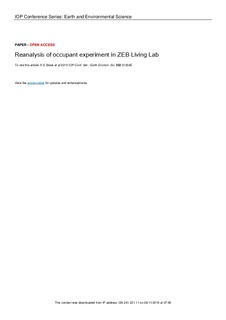| dc.contributor.author | Skeie, Kristian | |
| dc.contributor.author | Korsnes, Marius | |
| dc.contributor.author | Woods, Ruth | |
| dc.date.accessioned | 2019-12-02T13:09:57Z | |
| dc.date.available | 2019-12-02T13:09:57Z | |
| dc.date.created | 2019-11-06T03:41:42Z | |
| dc.date.issued | 2019 | |
| dc.identifier.issn | 1755-1307 | |
| dc.identifier.uri | http://hdl.handle.net/11250/2631276 | |
| dc.description.abstract | In 2015-2016, a six-month long experiment was carried out in the ZEB Living Lab, one of the first houses in Norway planned to reach net zero emission throughout its lifetime. By means of qualitative experiments, social scientists evaluated how six groups of occupants impacted the zero emission building, and how the zero emission building impacted its occupants in different ways. Data were collected through direct observation, diaries and interviews before, during and after the stay. In this paper, we take a closer look at the sensor data from the detailed monitoring system, generated during each group's 25-day long residing's. We find that despite the experiment being a controlled environment with many shared household characteristics, occupancy is determined by diverse factors, and the users' preferences and attitudes influence energy consumption. All major household appliances were the same, but the time of use, frequency, duration and type of use differed. The study contributes to increasing understanding of user behaviour and energy use in low energy houses. Providing occupancy profiles is valuable, in light of the increasing amount of local renewable energy production. These datasets can be used as input in energy simulation and planning of zero-emission neighbourhoods. | nb_NO |
| dc.language.iso | eng | nb_NO |
| dc.publisher | IOP Publishing | nb_NO |
| dc.rights | Navngivelse 4.0 Internasjonal | * |
| dc.rights.uri | http://creativecommons.org/licenses/by/4.0/deed.no | * |
| dc.title | Reanalysis of occupant experiment in ZEB Living Lab | nb_NO |
| dc.type | Journal article | nb_NO |
| dc.type | Peer reviewed | nb_NO |
| dc.description.version | publishedVersion | nb_NO |
| dc.source.volume | 352 | nb_NO |
| dc.source.journal | IOP Conference Series: Earth and Environmental Science (EES) | nb_NO |
| dc.source.issue | 1 | nb_NO |
| dc.identifier.doi | 10.1088/1755-1315/352/1/012045 | |
| dc.identifier.cristin | 1744403 | |
| dc.description.localcode | Content from this work may be used under the terms of theCreative Commons Attribution 3.0 licence. Any further distribution of this work must maintain attribution to the author(s) and the title of the work, journal citation and DOI. Published under licence by IOP Publishing Ltd | nb_NO |
| cristin.unitcode | 194,61,55,0 | |
| cristin.unitcode | 194,62,40,0 | |
| cristin.unitname | Institutt for arkitektur og teknologi | |
| cristin.unitname | Institutt for tverrfaglige kulturstudier | |
| cristin.ispublished | true | |
| cristin.fulltext | original | |
| cristin.qualitycode | 1 | |

